
Sargocentron is a genus of squirrelfish found in tropical parts of the Indian, Pacific and Atlantic Oceans, with the greatest species diversity near reefs in the Indo-Pacific. Being largely or entirely nocturnal, they have relatively large eyes. Red and silvery colours dominate. The preopercle spines are venomous and can give painful wounds. Most have a maximum length of 15–25 cm (6–10 in), but S. iota barely reaches 8 cm (3 in), and S. spiniferum can reach more than 50 cm (20 in).

The masked hamlet is a species of marine ray-finned fish, a sea bass from the subfamily Serraninae which is part of the family Serranidae, which also includes the groupers and anthias. This species is found in the western Atlantic Ocean in the Caribbean Sea and has been recorded from the coast of Central America from Quintana Roo in Mexico to Bocas del Toro in Panama and from Jamaica to Puerto Rico, as well as in the Turks and Caicos and the Cayman Islands. Its specific name refers to Providencia Island, Colombia where the type was collected. It was also recorded from other islands in the Archipelago of San Andrés, Providencia and Santa Catalina. They are a unique species in the Hypoplectrus genus, defined by their unique color morph. Their behavior is largely similar to that of other hamlets, especially in their diet and egg-trading spawning patterns.

Asthenosoma marisrubri aka Red Sea fire urchin and toxic leather sea urchin , is a relatively common sea urchin with a widespread distribution in the Indo-Pacific, and was till 1998 considered a color variant of Asthenosoma varium. Sea urchins are close relatives of starfish, crinoids, brittle stars and sea cucumbers, all being echinoderms.
Sargocentron borodinoensis, the Borodino soldierfish, is a member of the genus Sargocentron found in the Western Pacific Ocean in the Philippine Sea. It was discovered by the Borodino Submarine Elevation along one of the mountains, and is named in honor of it.
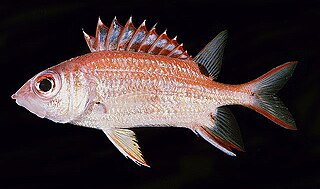
Sargocentron melanospilos, the blackbotch squirrelfish, is a species of squirrelfish in the genus of Sargocentron. It is found in the Indo-Pacific region in the Red Sea; Zanzibar, Tanzania; from Aldabra and Seychelles to the Marshall Islands and American Samoa; north to Taiwan, southern Japan and the Ogasawara Islands, and south to the southern Great Barrier Reef and the Chesterfield Islands. It is a relatively uncommon inhabitant of rocky reefs and coral-rich areas, and is usually seen solitary, but it also forms schools when in deeper water or oceanic areas.

Sargocentron hormion is a species of Squirrelfish belonging to the genus of Sargocentron. It is reported to have been found in Pitcairn, the Cook Islands and French Polynesia. It inhabits rocky bottoms and coral reefs.
Sargocentron inaequalis, the lattice squirrelfish, also known as the roundfinned squirrelfish, is a species of squirrelfish in the genus of Sargocentron. It is found in the Indian Ocean in the Chagos Archipelago, Comoro Islands, Seychelles and Réunion, and in the Pacific Ocean in he Line Islands in Kiribati. It is an uncommon inhabitant of rocky coral reefs.
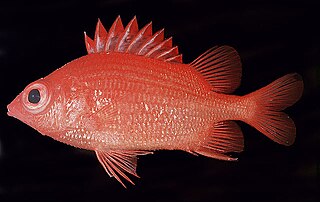
Sargocentron iota, the dwarf squirrelfish, is a nocturnal benthopalegic species of squirrelfish belonging to the genus of Sargocentron. It can be found in the Indo-Pacific region. It inhabits steep outer reef slopes.
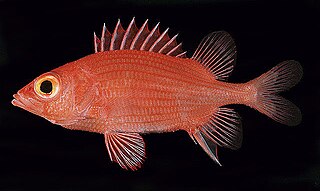
Sargocentron lepros, the spiny squirrelfish, is a nocturnal species of squirrelfish belonging to the genus of Sargocentron. It inhabits the outer reef slopes of oceanic islands, mostly in the Southern Pacific Ocean. It is normally found solitary.
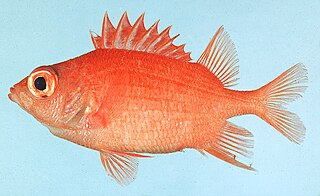
Sargocentron macrosquamis, the big-scale squirrelfish, is a species of squirrelfish belonging to the genus of Sargocentron. It can be found in the Western Indian Ocean, from the Red Sea to Mozambique, and in Seychelles, Maldives and the Chagos Islands.
Sargocentron megalops is a species of squirrelfish belonging to the genus of Sargocentron. It is endemic to Pitcairn in the Central Pacific Ocean. It possesses unusually large eyes, which it is named after, and is thought to be used for penetrating deeper water, suggesting 49m could be the near upper limit of the depth range of where it is found.
Sargocentron poco, the saddle squirrelfish, is a species of squirrelfish belonging to the genus of Sargocentron. It is found in the Western Central Atlantic Ocean from the United States to the Cayman Islands, and in the Bahamas. It may also possibly be found in Cuba. It is likely to be more commonly found inhabiting shelf-edge reefs.
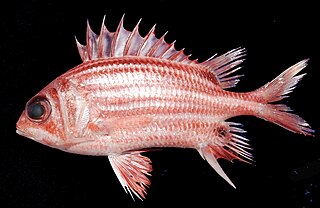
Sargocentrum praslin, the dark-striped squirrelfish, is a species of squirrelfish beloging to the genus Sargocentron. It can be found in the Indian Ocean and the West Pacific Ocean, from East Africa south to Mozambique and east to the Marshall Islands excluding the northern Marshall Islands and the Society Islands. It has also been introduced into Libya, Turkey and Cyprus and may also possibly be found in Egypt and Greece. It inhabits reef flats and shallow protected reefs, often in dead reef areas. It is secretive during the day.

Sargocentron Seychellense, the Yellow-tipped Squirrelfish, is a species of squirrelfish belonging to the genus Sargocentron. It is found in the Western Indian Ocean in Oman, the St. Brandon Shoals, Yemen in the Socotra Archipelago, Mauritius, Réunion, Comoros, Madagascar, the Chagos Archipelago and Seychelles, which it is named after. It inhabits shallow waters of coral reefs and rocky shores, and is often found between branching corals.
Sargocentron shimuzui, or Shimizu's squirrelfish, is a species of squirrelfish belonging to the genus of Sargocentron. It is named after ichthyologist Takeshi Shimizu. It is known from only 2 specimens that were taken with dynamite in Sulawesi, Indonesia in 1909.

Sargocentron suborbitale, the tinsel squirrelfish, is a species of squirrelfish belonging to the genus Sargocentron. It can be found in the East Pacific Ocean from the Gulf of California to Ecuador including the Galapagos Islands. During the day, adults of the species hide in small caves or crevices of rocks. During the night, they feed on small crustaceans in the intertidal zone. It is oviparous.

Sargocentron tiereoides, the pink squirrelfish, is a species of squirrelfish belonging to the genus Sargocentron. It can be found in the Indian Ocean and the Pacific Ocean, from East Africa to the Line and Society Islands, north to Ryukyu, Japan and Wake Island, south to Vanuatu, through Micronesia. It inhabits outer reef slopes of deeper waters and has been collected on reef flat and lagoon patch reefs. It feeds on benthic crabs and shrimp at night.

Sargocentron violaceum, the violet squirrelfish, is a nocturnal species of squirrelfish in the genus Sargocentron. It can be found in the Indian Ocean and the Pacific Ocean from Aldabra and the Laccadive Islands to the Society Islands, north to Ryukyu, Japan, south to the southern Great Barrier Reef, and from Palau to the eastern Caroline and Marshall Islands in Micronesia. It is an uncommon inhabitant atoll reef flats, lagoon patch reefs, and steep outer reef slopes. It is a solitary and secretive species and can occasionally be seen in small crevices in clear water habitats. It is usually among rich coral growth and it mainly feeds on benthic crabs and shrimps.
Sargocentron wilhelmi, or Wilhelm's squirrelfish, is a species of squirrelfish belonging to the genus Sargocentron. It is named after ichthyologist Friedrich Wilhelm. It is endemic to Easter Island in the Southeast Pacific Ocean.
Myripristis xanthacra, the yellowtip soldierfish, is a species of soldierfish belonging to the genus Myripristis. It can be found in the Western Indian Ocean in the southern half of the Red Sea and in Djibouti in the Gulf of Aden. It inhabits reef flats and slopes at depths below 18m.













